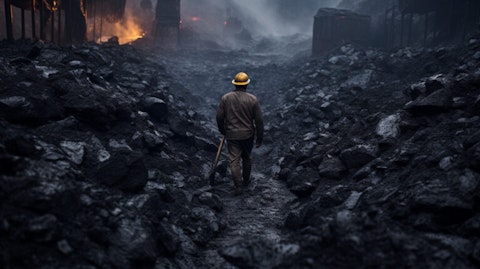Alliance Resource Partners, L.P. (NASDAQ:ARLP) Q3 2023 Earnings Call Transcript October 27, 2023
Operator: Hello. And welcome to the Alliance Resource Partners Third Quarter 2023 Earnings Conference [Operator Instructions] As a reminder, this conference is being recorded. It’s now my pleasure to turn the floor to Senior Vice President and CFO, Cary Marshall. Please go ahead, sir.
Cary Marshall: Thank you, operator, and welcome, everyone. Earlier this morning, Alliance Resource Partners released its third quarter 2023 financial and operating results, and we will now discuss those results as well as our perspective on current market conditions and outlook for the balance of 2023. Following our prepared remarks, we will open the call to answer your questions. Before beginning, a reminder that some of our remarks today may include forward-looking statements subject to a variety of risks, uncertainties and assumptions contained in our filings from time to time with the Securities and Exchange Commission and are also reflected in this morning’s press release. While these forward-looking statements are based on information currently available to us, if one or more of these risks or uncertainties materialize or if our underlying assumptions prove incorrect, actual results may vary materially from those we projected or expected.

A coal miner surrounded by piles of bentonite and Leonardite in a mine.
And in providing these remarks, the partnership has no obligation to publicly update or revise any forward-looking statements, whether as a result of new information, future events or otherwise, unless required by law to do so. Finally, we will also be discussing certain non-GAAP financial measures. Definitions and reconciliations of the differences between these non-GAAP financial measures and the most directly comparable GAAP financial measures are contained at the end of ARLP’s press release, which has been posted on our website and furnished to the SEC on Form 8-K. With the required preliminaries out of the way, I will begin with a review of our results for the third quarter, then turn the call over to Joe Craft, our Chairman, President and Chief Executive Officer, for his comments.
Total revenues in the 2023 quarter increased slightly to $636.5 million compared to $632.5 million in the 2022 quarter. The modest year-over-year improvement was driven primarily by higher transportation and other revenues, partially offset by lower oil and gas royalties. Total coal sales price per ton rose to $64.94 per ton for the 2023 quarter, an increase of 8.3% versus the 2022 quarter, and continues to reflect the positive impacts of our contracted order book. On a sequential basis, coal sales price per ton was 3.2% higher. In our Royalty segment, total revenues were $53.1 million, down 9% year-over-year but up 6.2% sequentially. Our results versus the prior year period reflect lower realized oil and gas commodity pricing that more than offset record oil and gas volumes and increases in coal royalty revenue per ton.
Specifically, Coal Royalty Revenue per ton was up 13.5% compared to the 2022 quarter, while lower commodity prices led to oil and gas royalties average realized sales prices being down 31.2% per barrel of oil equivalent versus the 2022 quarter. Sequentially, Coal Royalty Revenue per ton was up 3.7% and oil and gas royalties average sales prices were up 2.1% per barrel of oil equivalent. As it relates to volume, coal production decreased 7% to 8.4 million tons, while coal sales volumes decreased 7.9% to 8.5 million tons compared to the 2022 quarter. Compared to the sequential quarter, coal sales volumes decreased 5% due to lower sales volumes in our Appalachia segment. Coal sales volumes in Appalachia were down 15.2% compared to the sequential quarters due to lock outages, customer plant maintenance, a reduction in operating shifts at our MC mining operation, and challenging geologic conditions at our Mettiki longwall operation that has delayed development of a new longwall district.
Coal royalty tons sold declined 11.8% year-over-year, while oil and gas royalty volumes increased 28.2% on a barrel of oil equivalent basis year-over-year. The increased volumes from oil and gas resulted from the acquisition of additional oil and gas mineral interests and increased drilling and completion activities on our acreage. Turning to cost, segment adjusted EBITDA expense per ton sold for our coal operations was $41.19 per ton. An increase of 13.8% and 8 .8% respectively versus the 2022 in sequential quarters. Higher labor, maintenance, purchase coal and sales related expenses per ton, particularly in Appalachia, all contributed to the higher cost. The Appalachia segment adjusted EBITDA expense per ton increased by $11.06 per ton and $12.80 per ton respectively compared to the 2022 in sequential quarters.
Of the total increases, approximately $3.97 per ton and $5.91 per ton respectively were attributable to Mettiki which had the longwall idle during the full 2023 quarter. The longwall at Mettiki is expected to be back in production in the new longwall district in late November. Brokerage bought and sold at a profit in our Appalachia segment some high cost coal during the 2023 quarter which accounted for approximately $3.07 and $1.59 per ton of the increased expense compared to the 2022 in sequential quarters. The balance of the Appalachia cost increase during the 2023 quarter was due to a 20% drop in production at our MC Mining operation and adverse mining conditions and equipment availability at our Tunnel Ridge Mine, which resulted in several large unit shifts during the 2023 quarter.
Our net income in 2023 was $153.7 million, 8.4% lower as compared to the 2022 quarter. The decrease reflects lower coal sales volumes, higher production expenses, and lower realized prices in oil and gas royalties, partially offset by higher coal sales price per ton realization and higher volumes in oil and gas royalties. EBITDA for the quarter was $227.6 million, down 10.3% as compared to the prior year period. Now turning to our balance sheet and uses of cash, Alliance generated $123.7 million of free cash flow in the 2023 quarter. Our total and net leverage ratios were 0.36x and 0.17x respectively total debt to trailing 12 months adjusted EBITDA. Total liquidity was $629.5 million at quarter end, which included approximately $197.2 million of cash on the balance sheet.
During the 2023 quarter, we paid a quarterly distribution of $0.70 per unit equating to an annualized rate of $2.80 per unit. This distribution level is unchanged sequentially and up 40% versus the prior year quarter. Additionally, we reduced our outstanding senior notes balance by $54.6 million and completed two strategic new venture investments in the Ascend Elements and Infinitum during the 2023 quarter, totaling approximately $50 million. Now turning to updated guidance detailed in this morning’s release, we have elected to slightly adjust our full year 2023 coal sales volumes and pricing, which will be highly dependent upon logistics during the fourth quarter. We now anticipate ARLP’s overall coal sales volumes in 2023 to be in the range of 34.5 to 35 million tons.
Our committed tonnage for 2023 is 35 million tons. Of that total, 29.7 million is committed domestically and 5.3 million tons are committed to the export markets. We are encouraged by improving coal export market fundamentals based on recent international benchmark pricing. We believe there could be some incremental sales opportunities in late 2023 in the export markets. For 2024, we currently have 27.3 million tons committed, comprised of 25.7 million tons in the domestic markets and 1.6 million tons for the export markets. As we look to 2024, we do believe there is opportunity in 2024 for us to ship more tons into the export markets in 2024 versus 2023 levels based on current export market fundamentals. Sales pricing for the year is expected to be slightly lower than at the time of our last update.
We have chosen to modestly adjust our outlook for average coal price realizations for 2023 for a new range of $64.50 to $66 per ton from $65 to $66 per ton previously communicated. On the cost side, we have narrowed our full year 2023 segment adjusted EBITDA expense per ton to a new range of $39.50 to $40.50 per ton from the previous range of $38 to $41 per ton. We have fourth quarter 2023 longwall moves scheduled at our Hamilton Mine in the Illinois basin and our Tunnel Ridge operation in Appalachia. We do expect Appalachia segment adjusted EBITDA expense per ton in the fourth quarter to be approximately 8% to 10% higher than 2023 quarter cost per ton, while Illinois basin fourth quarter cost per ton are anticipated to be in line with the 2023 quarter.
In our oil and gas segment, we are reiterating our guidance ranges for the full year and all of our other guidance items are unchanged. And with that, I will turn the call over to Joe for comments on the market and his outlook for ARLP. Joe?
Joe Craft: Thank you, Cary and good morning, everyone. I want to begin my comments by thanking the entire Alliance organization for their continued hard work and dedication. I am proud of all that has been accomplished through the first three quarters of the year as we are on track to achieve another record year, beating last year’s full year’s revenue and net income numbers. Our well contracted coal order book enabled us to navigate an otherwise challenging operating environment during the 2023 quarter. Our Coal segment achieved higher realized pricing per ton sold relative to both the 2022 and sequential quarters. A theme that continues to favorably impact year-to-date results, particularly with regards to EBITDA and net income.
However, we did face some difficult mining conditions in Appalachia at all three mines during the 2023 quarter, which resulted in higher operating cost and fewer tons produced versus previous expectations. Mild weather experienced in the first half of the year, combined with lower natural gas prices throughout the year, have impacted coal consumption in 2023, preventing us from topping last year’s record coal sales volumes. As we look to next year, we have seen a recent increase in the natural gas forward curve, as well as a jump in API 2 pricing, due in large part to the conflict in the Middle East. At projected pricing levels, we believe that our export potential in 2024 will improve markedly as compared to the back half of 2023. Our Oil and Gas Royalty segment reported continued growth in the 2023 quarter, resulting in record production volumes, underscoring the success of recent acquisitions in core parts of the prolific Permian basin.
All those averages realized that pricing per BOE during the 2023 quarter was lower compared to near record levels in the 2022 quarter. Our Royalty portfolio is well positioned to provide significant cash flow via hedge-free exposure to commodity pricing cost free organically growth. We expect additional growth and production will lead to record production volumes in 2024 as we continue to invest in minerals. The strong cash flow generation of our underlying businesses positions us to continue improving our balance sheet and pursue the highest and best uses for our capital. During the quarter, we paid a regular distribution, repurchased and redeemed a portion of our outstanding senior notes and announced two exciting investments made by our New Ventures Group.
The first was a $25 million investment in Ascend Elements which is a U.S. based manufacturer and recycler of sustainable engineered battery materials for EVs. The investment was part of their $460 million Series D funding round which went combined with a $480 million DOE grant, will help advance the construction of North America’s first commercial scale manufacturing facility, producing cathode materials for EV batteries located essentially in our backyard in Hopkinsville, Kentucky. Beyond our initial contribution, we plan to evaluate additional partnership opportunities with the Ascend to expand our investment in the battery recycling industry and support the critical materials infrastructure needed to facilitate the onshoring of U.S. battery manufacturing.
The second investment included in an additional $25 million in Infinitum, a Texas-based developer and manufacturer of high-efficiency electric motors, as part of their ongoing Series E equity raise. If you recall, we originally invested in Infinitum in April of 2022, and with today’s announcement, our total investment in Infinitum is now $67 million, making us a meaningful investor in the company. We believe Infinitum’s patented air core motor technology has significant market potential, and our technology division, Matrix, is actively exploring opportunities to collaborate with Infinitum and incorporate the technology into our current mining operations. In closing, I am proud of ARLP’s performance year-to-date and encouraged by the opportunities in front of us.
We remain focused on finishing the year strong and gearing up for what should be another successful year in 2024. That concludes our prepared comments, and I’ll now ask the operator to open the call for questions. Operator?
See also Richest Cities in Every State in the US and 12 Best Undervalued Energy Stocks To Buy According to Analysts.
Q&A Session
Follow Alliance Resource Partners Lp (NASDAQ:ARLP)
Follow Alliance Resource Partners Lp (NASDAQ:ARLP)
Operator: [Operator Instructions] Our first question is coming from Nathan Martin from Benchmark Company.
Nathan Martin: Hey, thanks operator. Good morning, Joe, Cary. Appreciate you taking my questions. Just maybe a quick clarification to start. Cary, you mentioned Appalachian cost for ton could be up 8% to 10% in the fourth quarter. Just want to confirm that versus the 3Q ‘23 results, that’s 54, 84. And you also said a minute ago that IB costs, Illinois Basin costs should be flat. Was that also with the third quarter ‘23?
Cary Marshall: Yes, that’s right, Nate.
Nathan Martin: Okay, perfect. Thanks for that. And kind of moving on. I think when we talked last quarter, obviously the expectation was sales would outpace production in the second half draw down inventories, I think to around 0.5 million tons or so by the year end. Unfortunately, that didn’t really work out here in the third quarter, because in the items you guys mentioned, I think it was only about 100,000 ton draw. What do you need from a logistic standpoint to kind of get you to the high or the low end of your revised for your guidance? Are there any carryover effects from some of those 3Q items you guys mentioned, like the lock outage, customer maintenance, et cetera?
Joe Craft: Yes, so when you look at the sales range, we show that our contracted position for 2023 is 35 million. That’s what we are targeting to ship in for the full year. There could be logistical impacts that could drop that to the 34.5 tons are sold, whatever would not be delivered would be really primarily driven by making sure that we have the proper transportation and deliveries, vessel loadings, et cetera occurring during the fourth quarter. Whatever doesn’t occur in the fourth quarter, we’ll roll over into 2025. So part of our mix, when you get into sales price and you get into the volume, it does try to focus on what will be the specific contracts that are being served in the particular years. So, when you think in terms of the pricing, it’s really not from one quarter to the next.
I mean, the revenue is going to be basically the same. It’s just a timing issue. Cary mentioned in his prepared remarks that there is potential that we could pick up some additional export tons sells in the fourth quarter. If that were to happen, those would be at a little lower price than what our contract tons that would be rolled over into 2024. So that’s the issue. So from a volume perspective, if we can ship what we want to ship and what we plan to ship, we will be in inventory levels near where we talked about last quarter, I believe. If for some reason we get delayed and we go to the 34.5 and that’s going to push those inventory levels up. So it’s a matter of the logistics on shipping. I think from a production standpoint, our production impact for the quarter in both Mettiki and MC Mining is going to continue into the fourth quarter so we’ve had some people trying to retain sufficient people and our MC Mining has been a challenge for us so we had to reduce a unit of production at MC Mining Towards the back end of the last quarter that’s going to continue into the fourth quarter and then at Mettiki as Cary mentioned the longwall is not expected to start until the end of November.
So we’ll pick up a little bit of tons with the longwall production, but still we are, our production is limiting our ability to ship some export tons coming out of those two operations.
Cary Marshall: I think the only other thing I would add to that Nate is when I made reference to the lock outages and the customer maintenance issues, those are flowing now the customer that we were referring to and in our comments are back online now and the tons there are flowing as well.
Nathan Martin: Very helpful guys, appreciate that. And then maybe continue the export theme for a second you mentioned improving export cold demand then you’re based on our recent trends in the API 2 price as well as emerging opportunities in the markets. Can you talk about what those emerging opportunities entail and then second you mentioned ‘24 export potentially should improve markedly versus ‘23. So how many export tons do you expect this year and then how should we think about ARLP’s export tonnage over the next few years
Joe Craft: So right now we’re targeting 5.3, which is what we’ve got contracted. We could pick up another couple of vessels in 2023. So that number could go up a little bit. It’s also possible that number could slide a little bit depending on vessels for this particular year. As we looked at next year as we’ve said previously, we believe we have a strong domestic market share for right at 30 million tons. We do think, however, in 2024 that there’s still continuing overhang of inventory at our utilities. And we expect that the market pricing for exports going to be better than the domestic market. So we may be a tad lower than the 29.7. Maybe it’s 28, don’t know for sure. And whatever that would be, it would flow into the export market as we think of our sales for 2024.
Right now, I think a conservative estimate is consistent with what we’re doing in 2023. But we do have, we believe we would have the potential based on what we’re seeing in the export market right now to possibly expand that to 36 million. If the export market opportunities do, in fact, occur as we’re projecting. So there could be that spread of maybe going as high as 7.5 million to 8 million tons in the export market next year. It’s going to be depended between the domestic and export opportunities that are presented to us in 2024.
Nathan Martin: Got it, Joe. Thanks. And then just maybe wrapping up with a question on the domestic side. I think you mentioned last quarter there were a number of customers out with RFPs looking to fill their books up for ‘24 and beyond. I think many for multiyear periods. You mentioned some of the issues we’ve had this year with high utility stockpiles and net gas prices. But it should be great to get your updated thoughts on what you guys are seeing in the market and how that demand looks for the next couple of years.
Joe Craft: Yes, we are seeing a couple of, we’re participating in a couple of solicitations right now for tonnage in the 2025 to 2028 time period. Again, for 2024 there is some solicitations also, there are more volumes in the out years than it is in 2024. When we look at the tonnage, we were able to book in the third quarter, we actually booked 1.1 million tons of opportunity, but it’s mostly in 2023. And then that has allowed for some rollover into 2024 as we look at that position. So again, we’re very comfortable that 2025 the market reopens to where we will be at that 30 million ton level at least on domestic sales. And we would like to expect that that’s going to continue through the balance of this decade that we would be at that 30 million ton level domestically and feel that the contracts will definitely be there for us as we progress looking forward for the next decade, until the end of the decade.



